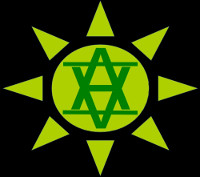
ASTRONOMOLOGY
The Reuniting of Astronomy & Astrology
Phase 7 in PART 3 of Project Freeman
A  Initiative
Initiative
by

 |
ASTRONOMOLOGYThe Reuniting of Astronomy & AstrologyPhase 7 in PART 3 of Project Freeman |
A
|
This Site Uses The 'Freeman Calendar' - The Universal Celestial Calendar (UCC)
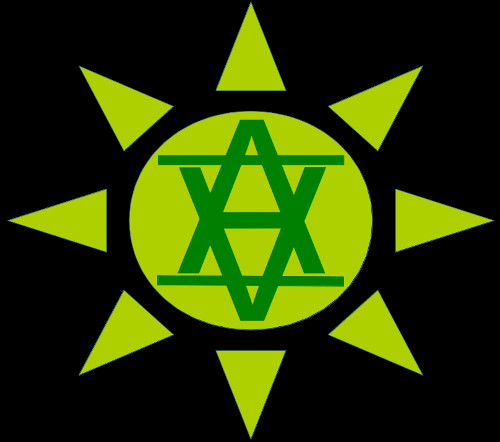
The Graphic symbolises the coming together of the two 'A's of Astronomy & Astrology in a Six Pointed Star formation
The Six Pointed Star is normally constructed of two triangles representing the 'Sacred Masculine' & 'Divine Feminine'
is represented by the Upward pointing triangle and is typically associated with the Left Hand Side of our Brains
is represented by the Downward pointing triangle and is typically associated with the Right Hand Side of our Brains
In the case of our graphic here then by association:
The Upward pointing A represents the A of Astronomy, a reasonably modern Science of Physics (Left Hand Brain/Masculine)
The Downward pointing A represents the A of Astrology, an ancient Science more associated with Meta Physics (Right Hand Brain/Feminine)
Astronomy grew out of Astrology, the more ancient art, but still uses many of the terms it inherited from its ancient sibling
It's rare these days that we find astronomers who respect astrology, but in my view we can never get the full picture about anything unless we study BOTH sides of the equation and use BOTH sides of our brains, and that's what I plan to share on this site.
Let's start with how to read your astrological birth chart (using Western/Tropical astrology)

© Litmus A Freeman - 1 Pisces 13519 UCC (18th February 2019)
I'm presenting 'The SHAPE of My Chart' in a series of shows on Holistic Radio. The audio of the shows are embedded here together with the graphics referred to in each show, starting with the Introduction below.
In astrology we usually start by producing a Birth Chart, also known as a 'Natal' Chart such as the one below:
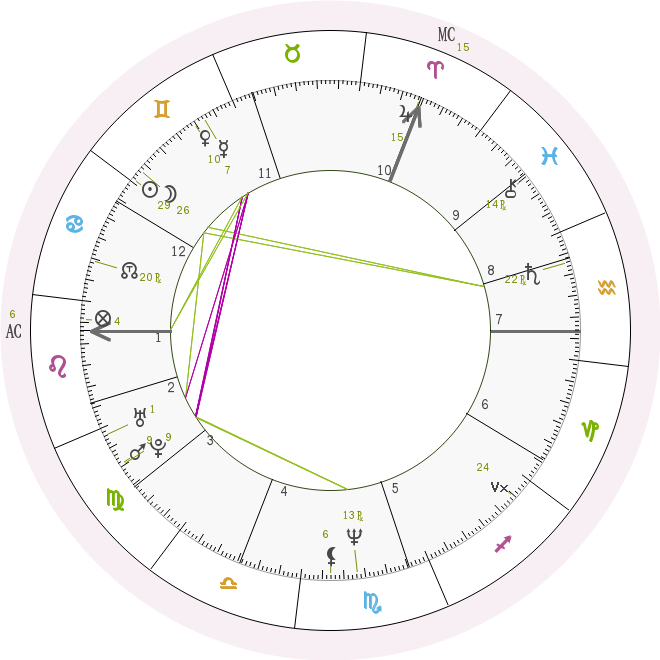
These charts can be produced freely on line at many websites.
The ones I use most are:
Cafe Astrology (beginners)
The charts are produced by entering the Time, Date and Place of birth into the websites' calculators
You are at the centre of the chart surrounded by a snapshot of the earth and its position relative to the rest of the solar system when you were born
Your birth chart is like the synopsis of your 'Life Movie' or 'Play'
I came up with a handy way to remember the main components of a birth chart using the acronym 'S.H.A.P.E.' - the SHAPE of your chart! These are:
The Signs are the 12 Signs of the Tropical Zodiac commencing with Aries and ending with Pisces. These are in fact the 12 months of the year as the tropical zodiac is a Seasonal Solar Calendar which shows the annual journey of the Sun.
There are also 12 'Houses' which represent the main areas of our lives based on the 'Cycle of Growth' and correspond with the 12 Signs/Months
The Aspects are angles that the planets make to each other relative to our time and place of birth on the earth, affecting us in either positive or challenging ways.
The Planets include the Sun and the Moon and are shown in the chart by their respective symbols.
The Energies in the chart at birth depend on the positions of the Planets, and their Aspects to each other, in the Signs and the Houses
We can rearrange the letters of 'SHAPE' to form 'PASHEn', to best describe how these main components of our birth charts work and to help us discover our life 'PASHEns'
So let's put them in that order:
Now let's see how they work in our birth charts...
The Planets are the ACTORS in our life movie. They each have an archetypal energy and influence the traits that make us what we are. So they can be considered to be the WHAT? or WHO? is affecting us energetically
Here are the planets with their astronomological symbols and where you will find them in a typical birth chart, in the middle 'sky' circle.
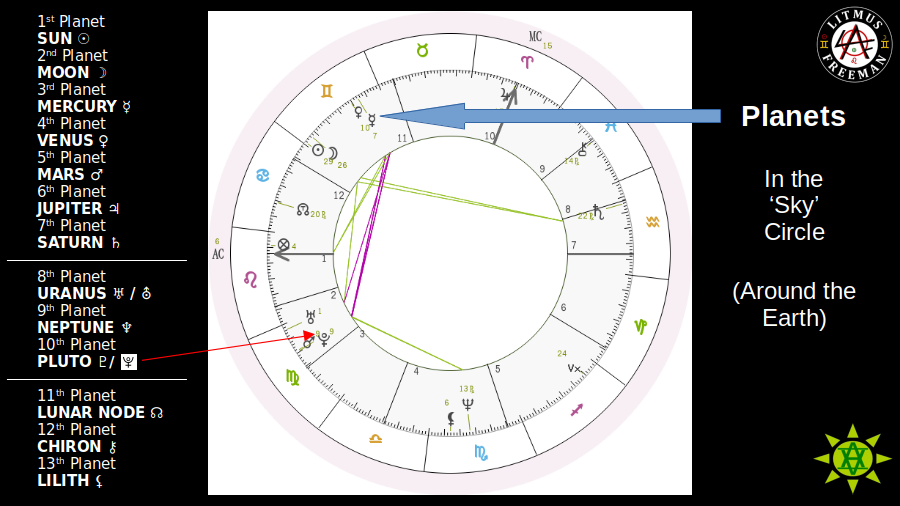
(Note: Pluto, like Uranus, has two recognised symbols. You may find either of them in your chart, depending on which site you get it from. The red arrow in the graphic points to the alternative symbol for Pluto in the chart used here. The symbols can also look a bit different depending on the font used, but you'll soon get used to recognising them).
The Aspects are the meaningful angles that Planets can make to each other and so show us which Actors are inter-acting with each other. The energies of Planets in Aspect to each other combine to influence us in various harmonious or challenging ways depending on which Planets are in Aspect and how they are in Aspect
The aspects are shown in our charts by the lines crossing the centre 'earth' circle as shown below:
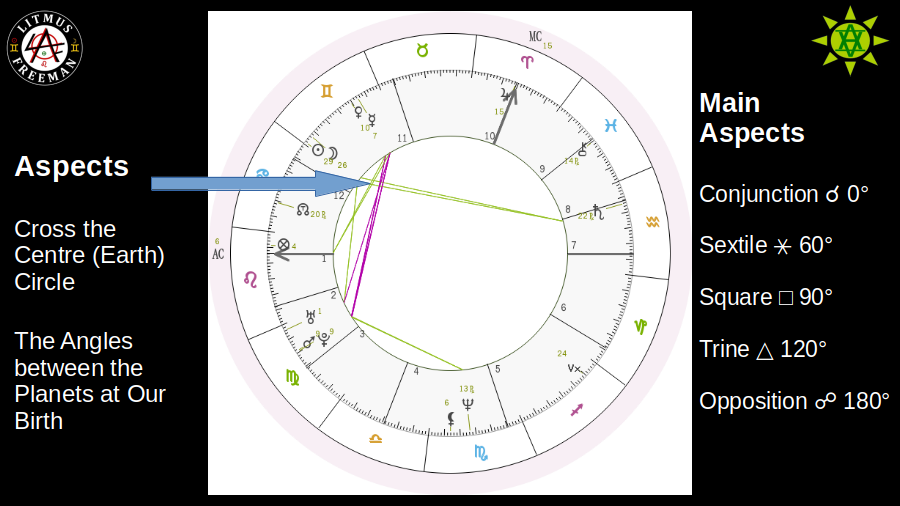
The main Aspects are Conjunction, Sextile, Square, Trine and Opposition as shown above
The Signs (the 12 months of the year) that the Planets are Acting in represent the Roles they are playing and the Costumes they are wearing in our life movie. The Sign modifies the archetypal energy of the Planet in a particular way, depending on the Sign in question. So they are considered to represent HOW? we are being affected by the Planetary archetypes
The Signs are shown by their symbols, moving counter-clockwise in the outermost circle of our charts as shown below:
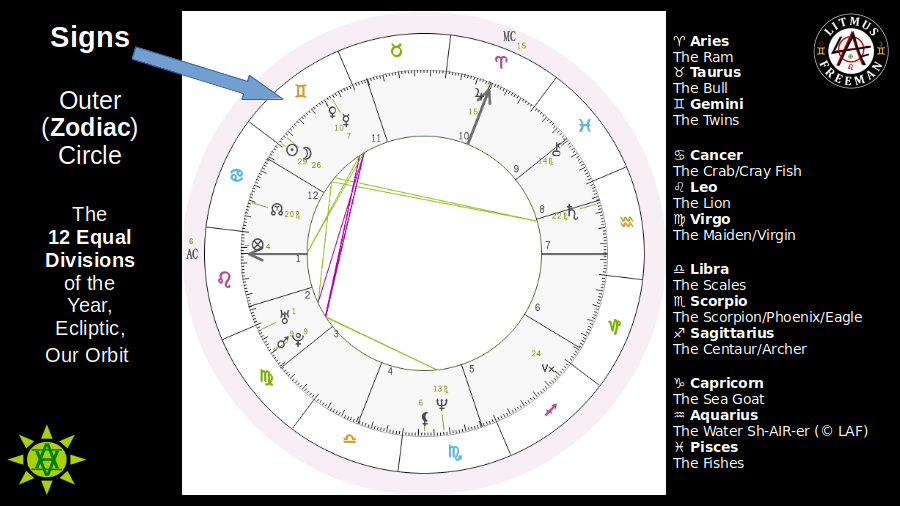
These 12 Signs, being the original 12 months of the year, are named after the 12 Zodiac Constellations of Stars which we can observe in the night sky over the course of the year.
The Houses represent WHERE? in our lives the planetary Actors are playing their Roles. Each of the 12 houses represents one of the 12 main archetypal areas of life, based on the 'Cycle of Growth' from birth to death.
They are usually shown as divisions of the middle 'sky' circle in our charts.
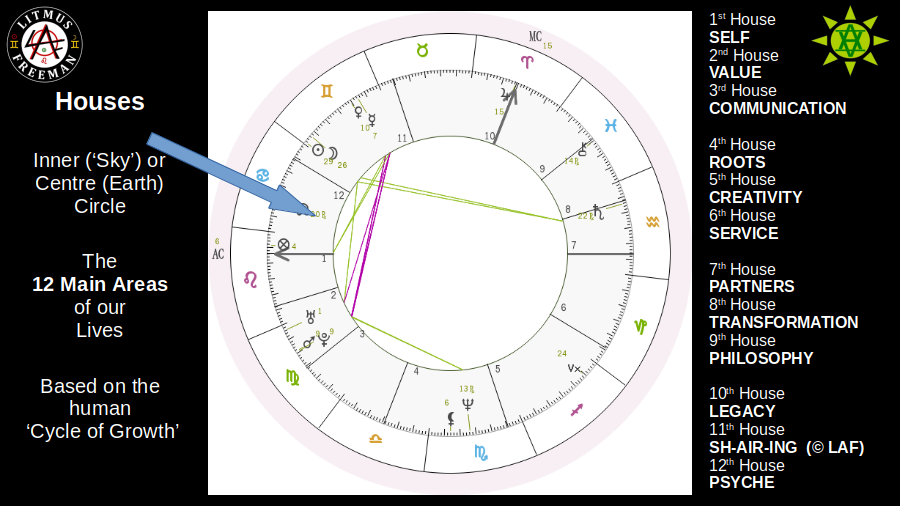
Unlike the Signs, which are all equal 30 degree segments, the Houses can vary in size depending on where and when we were born (and the house system used to produce the chart, but more of that later)
Putting all this together we can see the combination of Energies that are influencing us based on which Actors, together with which other Actors, are playing what Roles, and Where they are playing them, in the movie of our life
A summary of this is shown in the graphic below
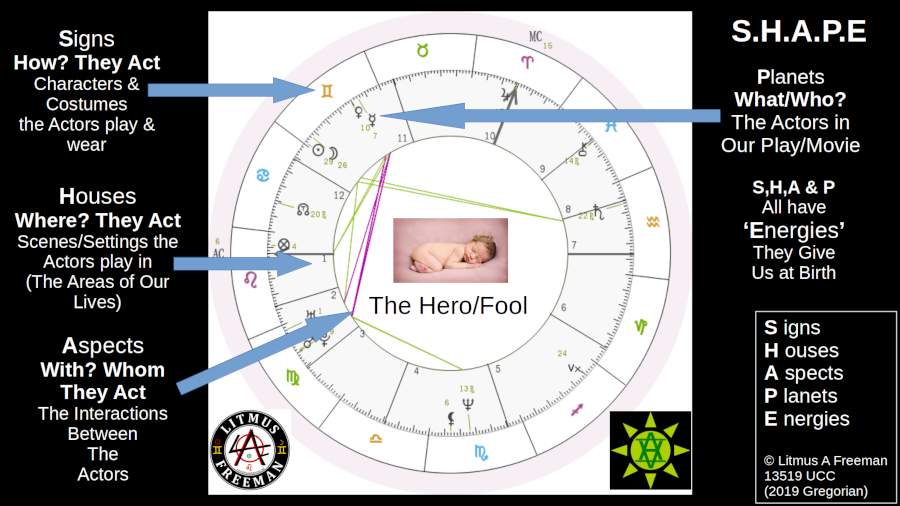
Now let's look at the 'astronomology' of these 'PASHEn-ate' parts of our birth charts in turn, to understand these Energies in more detail...
The word planet derives etymologically from the Greek term for 'wanderer' or 'wandering star', as our ancestors noticed that they moved considerably, relative to the background stars.
The graphic below shows some of the astronomical data of the planets of our solar system; their relative positions (NOT to scale) moving out from the sun, an idea of their relative sizes and the time in years they take to orbit the sun, with earth, at one year, as our main time reference.
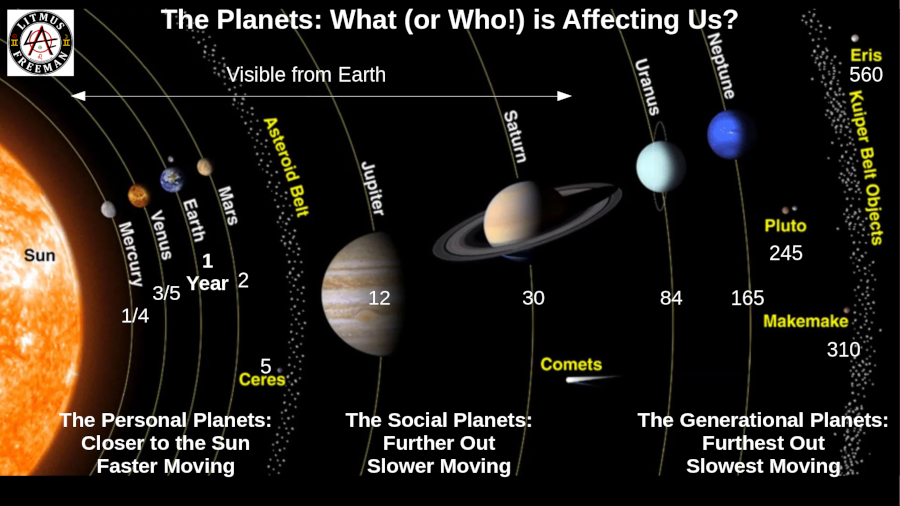
The graphic also shows the astrological classification of the planets in terms of their influence over us in societal groups, affecting us more individually and personally, socially or generationally, depending on their distance from the sun. The faster moving planets closer to the sun - Mercury, Venus and Mars - will more likely be in different Zodiac Signs for each of us, as they change Signs more frequently, wherease larger groups of people, born in the same year to two and a half years of each other are more likely to share the same Jupiter & Saturn Signs as they change Sign less frequently due to their longer orbits.
The further out planets - Uranus, Neptune & Pluto - move even slower, so a whole Generation of people can share the same Sign for these planets, and so the same energetic influence from them.
For the planets from Mars outward just divide the length of their orbits by 12 to see roughly how long each of them spends in one Zodiac Sign.
The next two images show just how huge the Sun is in relation to its planets, and how those planets compare in size
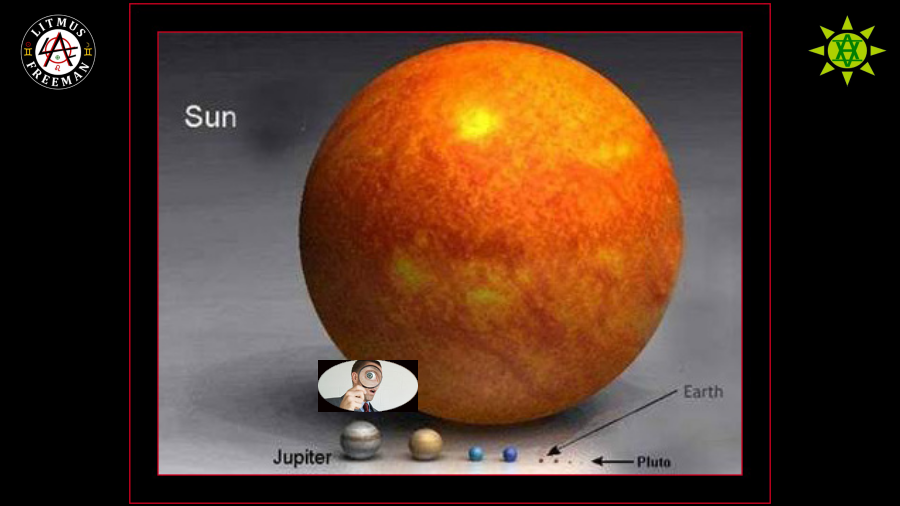
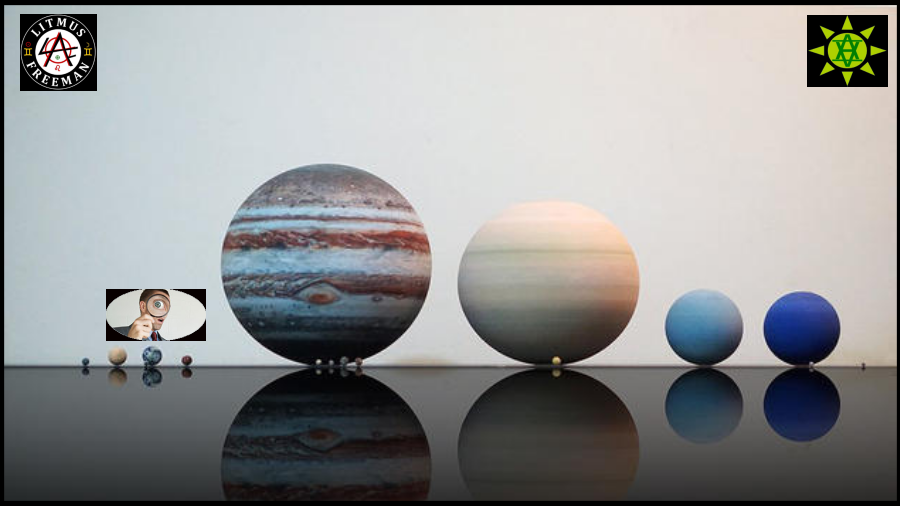
The planets in Heliocentric order, from left to right:
Mercury, Venus, Earth, Mars, Jupiter (with its 4 largest moons), Saturn (with its largest moon), Uranus, Neptune, Pluto
One of the main ways the planets affect us is through the force of gravity which is proportional to their mass, so that the more massive a planet is the more pull it has on the others. Jupiter for example, although small compared to the Sun has a gravitational force strong enough to move the Sun off its centre as it rotates. This creates a 'barycentre' as shown below.
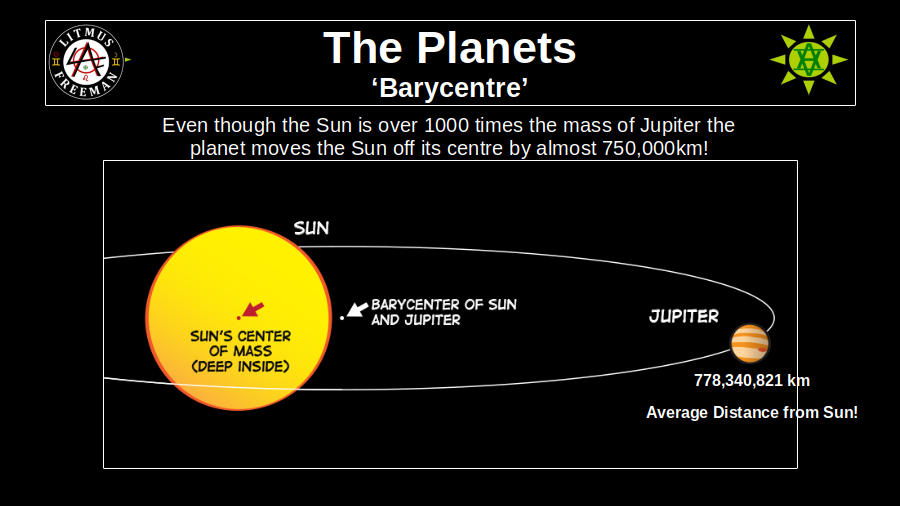
Jupiter moves the sun a distance somewhat proportional to its relative mass. If it can do that to our massive solar system star imagine the effect it can have on us, as small beings on a relatively tiny planet.
The moon does a similar thing to the earth. The moon is very large for a moon. The moons of the other planets are tiny compared to their host planets. Our moon, at one sixth the size of the earth, is more like a twin planet than a moon. Its gravitational effect pulls on the oceans of the earth to create the tides, and a barycenter between it and the earth as shown below.
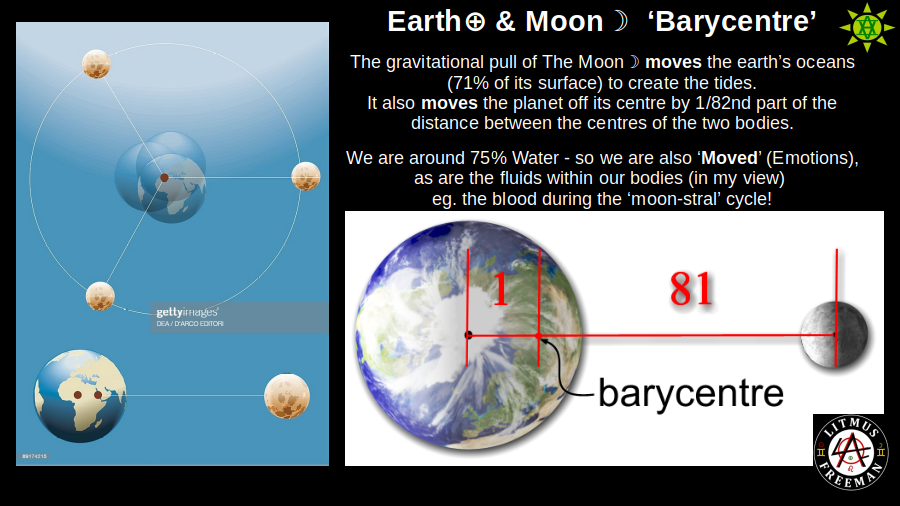
We are mostly water and so like the oceans, can be 'moved' by the moon. This is why astrologically the moon is said to affect our emotions, like the oceans.
And so, what about the other planets?
The next graphic summarises the metaphysical qualities, the astrological influences as it were, of the planets, partially based on their astronomical characteristics. They are shown in the 'geocentric' order from our perspective on earth, from the closest planet, The Moon, out to the most distant, Pluto.
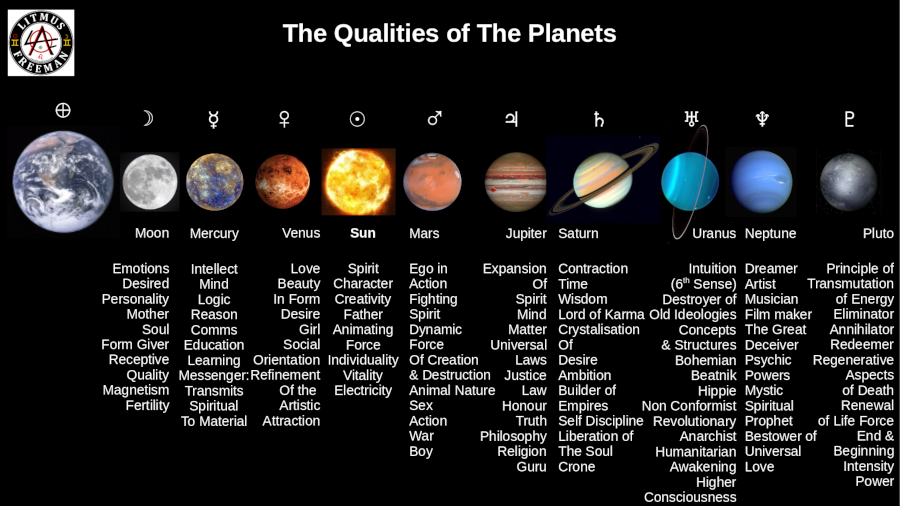
Below is my attempt to summarise these influences in a single word for each planet!
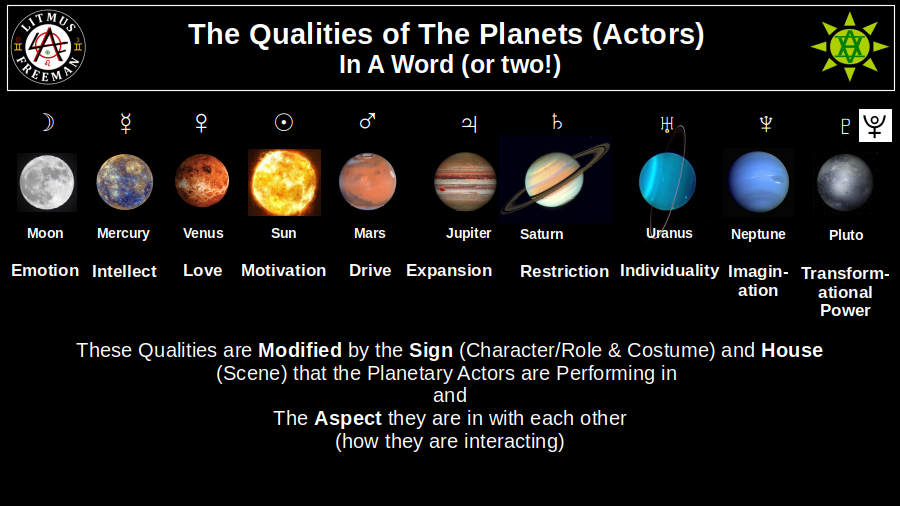
As we saw in our example chart above, the Aspects are the Angles that planets make to each other and the main Aspects are Conjunction, Sextile, Square, Trine and Opposition. Let's look at these in a bit more detail.
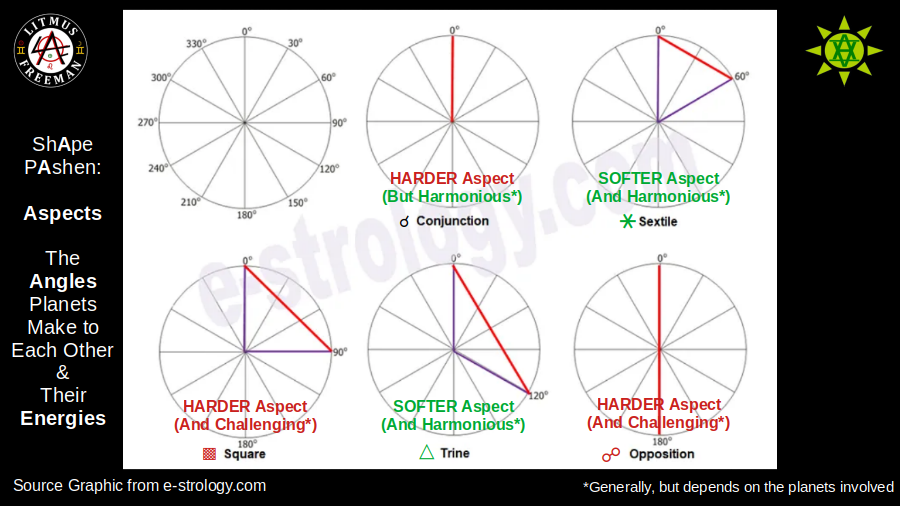
So we have 'Harder' & 'Softer' Aspects which can be 'Harmonious' or 'Challenging'. The main aspects we're looking at here are combinations of these qualities.
My friend in astrology, Su Newman, provided some keywords which summaries how these En-ergies can manifest.
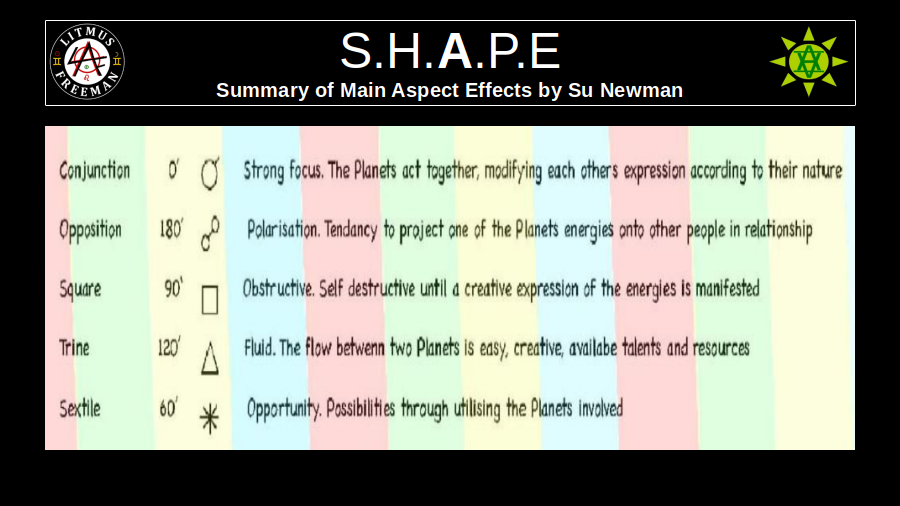
ASPECTS EXERCISE:
Have a look in your own Birth Chart to see what Planetary Aspects you have.
What do these suggest to you about your 'Astro-Psychology'?
Below is Helen's chart that we discussed in the show. Try doing the same exercise with your own chart.
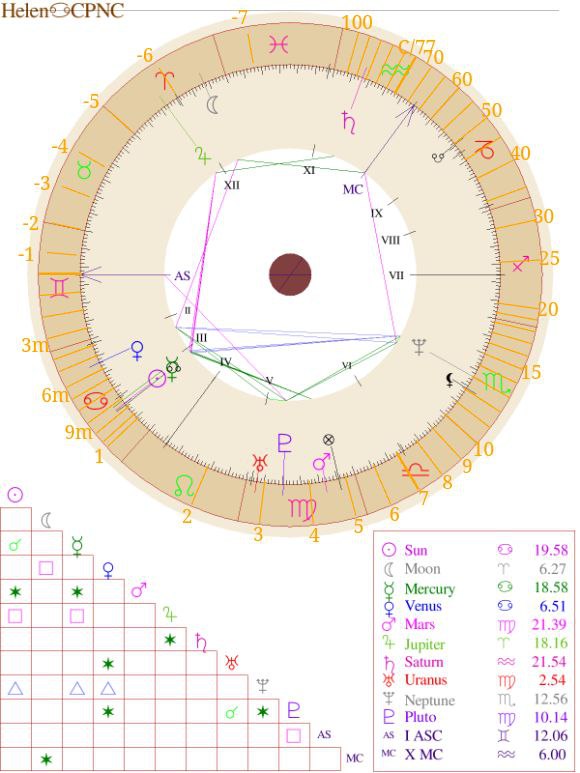
As we saw above, the 12 'Signs' of the Zodiac are the 12 months of the year, the 12 divisions of the earth's orbit around the sun, as shown in the grpahic below
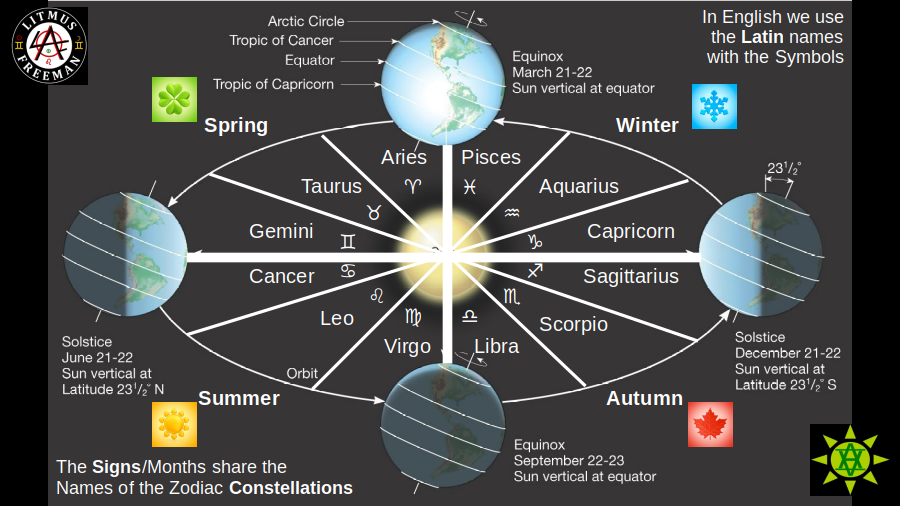
The earth orbits the sun in a counter-clockwise direction and also rotates counter-clockwise on its axis which is tilted at 23.4 degrees and so points more towards or away from the sun as it orbits. From a northern hemisphere perspective, when it is tilted most towards the sun it is at the point of SUMMER solstice (solar stasis), when the sun is above the earth's Tropic of Cancer and giving the longest day. When it is tilted most away from the sun it is at the point of the WINTER Solstice, when the sun is above the earth's Tropic of Capricorn and giving the shortest day. At the mid points between these two extremes the axis is side on to the sun and the length of day and night are equal. These are called the 'Equinoxes' (meaning 'equal night' in latin). The equinoxes and solstices divide the year into four quarters, creating our four seasons. Each season is divided into three equal divisions each of 30 degrees making twelve equal 30 degree divisions of the year in total. These are the 12 'Signs' of the Zodiac and the 12 months of the natural astronomological, seasonal year. They are named after the 12 Zodiac contellations of stars from Aries through to Pisces
Our astrological birth charts show us where in each of these Signs the planetary Actors were acting at the time and place of our birth.
Each of the 12 Signs has a unique combination of energies which determine the type of role the planets are playing in our Life Movie. I use the acronym 'P.E.N.' for these, Polarities, Elements, and Nature as shown below
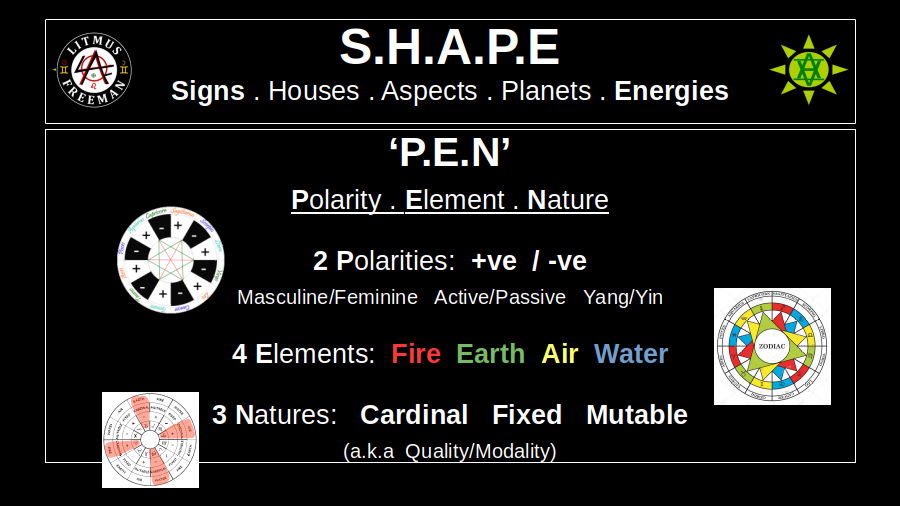
The 2 Polarities of the Signs alternative between positive to negative as we proceed around the Zodiac from Aries to Pisces:
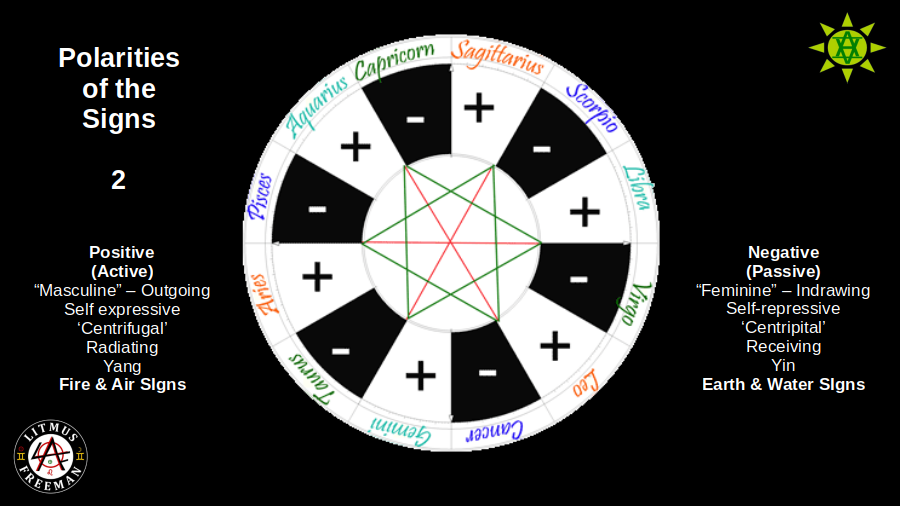
The 4 Elements of the Signs - Fire, Earth Air & Water - repeat in that order from Aries to Cancer, Leo to Scorpio and Sagittarius to Pisces, as shown below with their respective elemental symbols
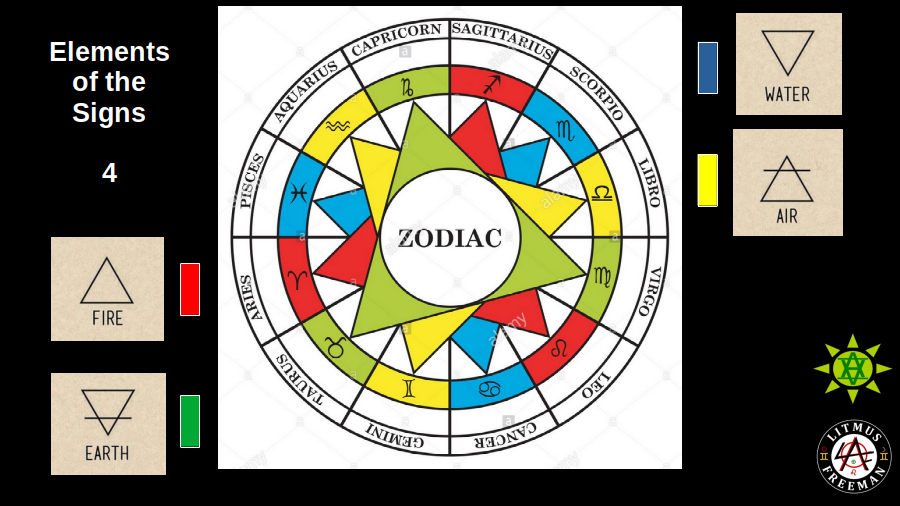
The planatary energies typically express through the elements in the following ways:
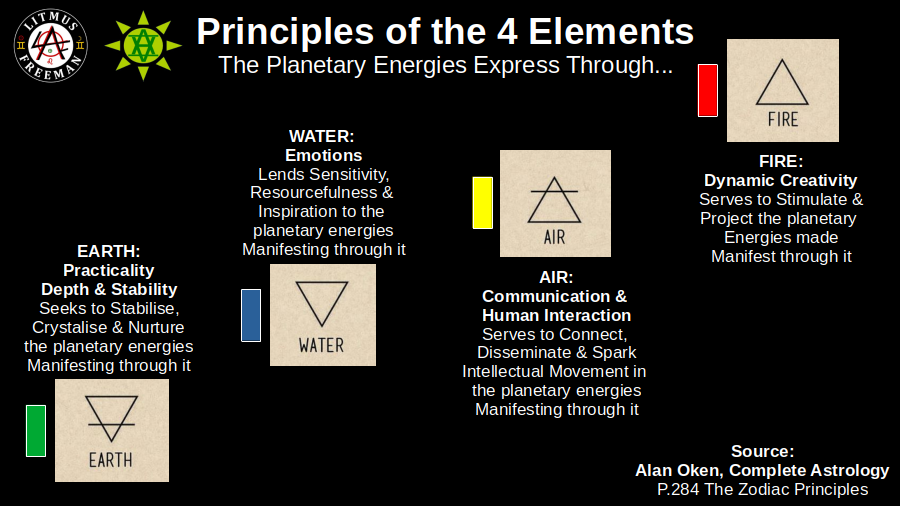
The 3 Natures (also known as 'Qualities') of the Signs - Cardinal, Fixed and Mutable - repeat in that order for each of the four quarter seasons of the Zodiac year. These are shown below with their symbols on the left and how their energies tend to manifest.
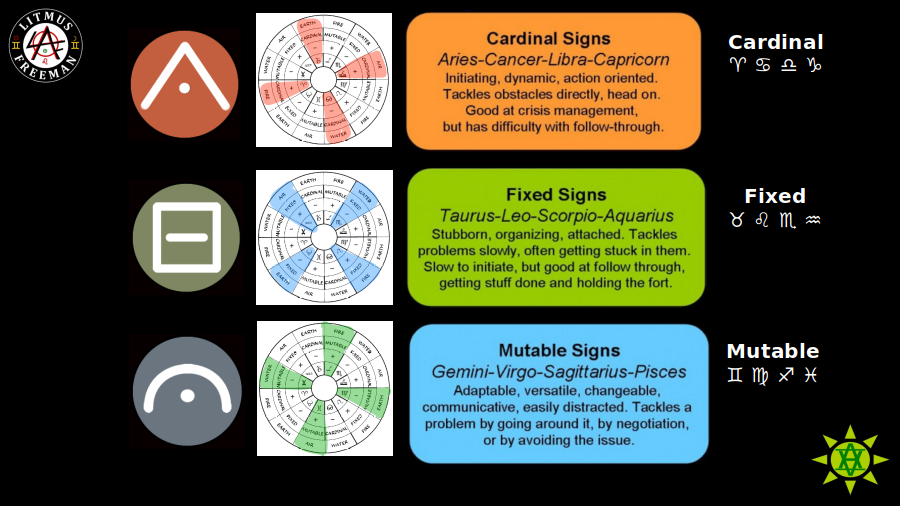
Putting all these 'P.E.N-ergies' together in the Zodiac we get the following combinations of Polarity, Element and Nature for each of the 12 Signs (with thanks to whoever produced the colourful image and shared it freely online)
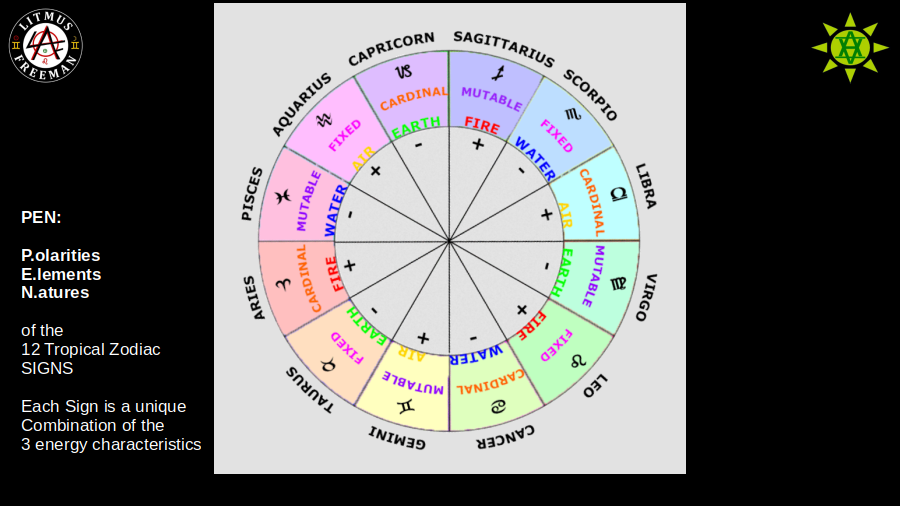
These are excerpts from 'The SHAPE of My Chart' - a Project Freeman Wisdom Workout with the full presentation embedded there and also here below if you want to already get into all the details
You can also check out another example of 'Astronomology' featured at the Wiki Page of the Universal Celestial Calendar:
© Litmus A Freeman 13512 UCC (2012 Gregorian) Onwards